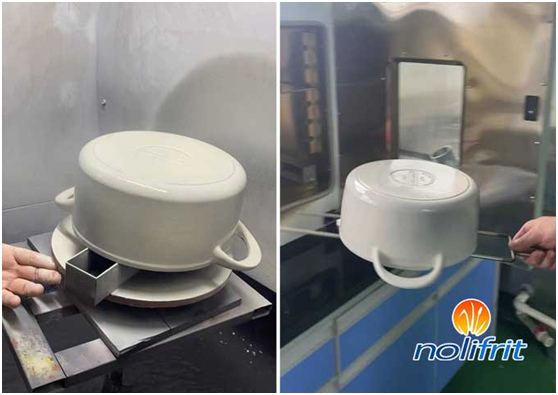Enamelling and Firing of Cast Iron Enamel
Spraying (spraying method) is mostly used for wet enamelling of cast iron enamel. Before the white enamel is applied, it is best to fire the ground coat first, but most will spray the cover coat directly on the casting and fire it. Castings are inspected before enamel is applied, and all cavities are filled with dry enamel to prevent air from escaping during firing. The spraying method used for wet enamelling of cast iron enamel is similar to that of steel plate enamel. The key point is to spray a uniform thin layer, basically using artificial spraying.

The ground coat of cast iron enamel dry method can be soaked or sprayed, and a thin layer of enamel is applied on the casting. When it is inconvenient to soak large objects, the enamel can be flowed through the casting, or the enamel can be applied by spraying. When applying enamel by spraying, a small amount of iron oxide can be added to the enamel slurry. After the enamel is dried, it needs to be inspected, and the gaps and gaps need to be repaired. The dry method of enamelling requires experience and skills. After the red-hot body is taken out of the furnace, the sieved enamel powder is sprinkled on it immediately, and the enamel is fired on the surface by using the residual heat of the body, and then re-introduced into the furnace. medium firing.
For the firing of wet cast iron enamel, due to its large volume, the firing time should be extended, but in order to prevent the enamel from overboiling, the firing temperature should be appropriately reduced. Wet enamel firing will boil in the early stage of firing, but the boiling will gradually stop in the later stage to form a smooth film. The gas that promotes the boiling may come from the decomposition of the clay, the gas contained in the casting, or the gas formed by the reaction of the enamel with the iron.
The green body of dry cast iron enamel is larger, and the firing temperature should be raised slowly, which can usually be divided into two stages of firing. During the preheating stage the object is only heated to a bright red color and then moved into a firing furnace (840~925°C). When the temperature of the casting reaches the temperature of the firing furnace, it is quickly removed and sprinkled with enamel powder, and then placed back in the furnace until the enamel melts into a smooth surface.
Cast iron baking plate enamel performance: general cast iron enamel can be divided into three types according to gloss, as follows:
A. Gloss: Gloss: 60~85°. (high gloss above 85°) heat resistance test: after 30 minutes of empty firing at 450 ℃, put it in room temperature water, the enamel will not change.
B. Flat: Gloss: 30~60°.
Heat resistance test: after 30 minutes of air firing at 450°C, the enamel will not change when placed in room temperature water.
C. Matt: Gloss: below 30°.
Heat resistance test: after 30 minutes of empty firing at 500°C, put it in room temperature water, the enamel will not change.